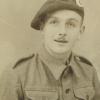Hamilcar glider, chalk number 501. FROM ‘ONE NIGHT IN JUNE’. Hamilcar 501, nicknamed the ‘Bag of Bagdad’ and flown by Staff Sergeant Leslie Ridings and Sergeant Ronald Harris, ran into trouble shortly before the LZ. The combination had had the unusual experience, four minutes before reaching the coast, of a parachute floating down past the Halifax and hitting the starboard wing of the glider, although no damage was caused. Flying Officer Sizmur, the captain of the towing Halifax, reported that the tow-rope broke at 0327 hours, two minutes after they had crossed the coast. He thought that the Hamilcar may have actually landed on the LZ. Sadly, he was wrong.
The Hamilcar landed in an orchard near the village of St. Vaast-en-Auge. At dawn, the Germans attacked the glider, killing three of the gunners from 3 Airlanding Anti-Tank Battery - Bombardier William Whitney, and Gunners Frank Newham and Douglas Stanley. Staff Sergeant Ridings was mortally wounded and died the next day. However, Sergeant Harris managed to escape and joined up with a sergeant-major and a sergeant from the 1st Canadian Parachute Battalion, who had been dropped eight miles from their DZ. The three men managed, without the help of the local population, to evade capture for ten days before being caught by the Nazis near Pont 1’Eveque.
The other major event. This was the first time that HAMILCARS were ever flown on an airborne operation and the first time 17-pounder anti-tank guns were to be taken into action by air. Only four HAMILCARS intended to land on L/Z ‘N’, RANVILLE, that night, but only two managed to reach RANVILLE, Hamilcar CN500 and CN503. Hamilcar CN502 had to land at Ford (England), as the tow rope broke over Bognor Regis.
Hamilcar CN501, which pilots were S/Sgt Leslie RIDINGS, and Sgt Ronald HARRIS, had to land in a farm at Saint Vaast En Auge, because the tow rope broke over the sea off Villers Sur Mer, probably because of the Flak. The glider was still a long way from its intended landing zone (12 miles S/E), but the pilots had no choice. Sgt Leslie RIDINGS, managed to land correctly, but it seems that he was injured in the landing, as the cockpit hit branches.
Once again, the three Canadians, Sgt Major HALL, Sgt LA CROIX, and Sgt BROWN, saw the landing. They met the crew and passengers (five of them), and as they were lost, they decided to go and ask their location at a nearby farmhouse. Sgt Major HALL, who was able to speak French, took Sgt BROWN, with him. As they spoke to the Landlady, they heard the burst of a machine gun fire. When they were back at the place were they left their mates, they found four dead Brits (S/Sgt Leslie RIDINGS, Bombardier William WHITNEY, Gunner Douglas STANLEY, Gunner Frank NEWHAM), and Sgt LA CROIX was mortally wounded. Sgt BROWN treated Sgt LA CROIX with morphine, and then left him. The 2 Canadians, and Sgt Ron. HARRIS evaded for 10 days, and were captured near Pont L’Eveque. The remaining gun crew (5 men) protected the escape by hiding along the hedgerow, and they were taken prisoners at about 16.00 on 6th June 1944. S/Sgt Leslie RIDINGS was still alive at that time.
FROM AIRBORNE ASSAULT MUSEUM RESEARCH:
Gun Detachment ‘A’ Troop, 3rd Airlanding Anti-tank Battery, Royal Artillery.
Number. Rank and Name. Fate. POW Camp and number.
4923938 Sgt. T.W. CANNON. Captured 6/6/44. 357, 81145.
4924410 Bdr. William WHITNEY. Killed 6/6/44
1074775 Bdr. K. HARDING. Captured 6/6/44. 357,82300.
14207549 Gnr. F. NEWHAM. Killed 6/6/44
5059287 Gnr. D. STANLEY. Killed 6/6/44
4928955 Gnr. J. GRAINGER. Captured 6/6/44. D.L. 21.
4924545. Gnr. E. BATES. Captured 6/6/44. 4B, 82249.
4924031. Gnr. PALLET. Captured 6/6/44





Latest Comments
There are currently no comments for this content.
Add Comment
In order to add comments you must be registered with ParaData.
If you are currently a ParaData member please login.
If you are not currently a ParaData member but wish to get involved please register.